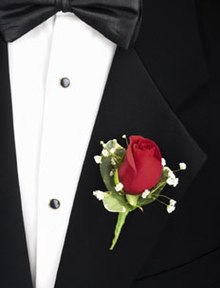

A boutonnière (French: [bu.tɔ.njɛʁ]) or buttonhole (British English) is a floral decoration, typically a single flower or bud, worn on the lapel of a tuxedo or suit jacket.
While worn frequently in the past, boutonnières are now usually reserved for special occasions for which formal wear is standard, such as at proms and weddings. (Women who wear jackets on these occasions may also wear boutonnières, but more typically a woman would wear a corsage.) Nowadays, lapel pins are worn more often than flowers on business suits.
Traditionally, a boutonnière is worn pushed through the lapel buttonhole (on the left, the same side as a pocket handkerchief) and the stem is held in place with a loop at the back of the lapel. The flower's calyx, if pronounced such as that of a carnation, should be fully inserted into the buttonhole which would secure it tightly and flat against the lapel. Thus the buttonhole should ideally be at least 1+1⁄8 in (29 mm) long for there to be enough room to fit a standard-sized flower's calyx. Otherwise, the calyx would not fit into the buttonhole, and the flower head would hang freely and move about in the wind.
However, on many recently made coats and jackets, the lapel is made without any loop, which would normally sit on the reverse of the lapel, beneath the buttonhole. Sometimes, the lapel buttonhole is in the "keyhole" shape, as opposed to the traditional straight cut, or is not even pierced through, in which case the boutonnière may be pinned onto the jacket lapel, although this may be considered unsightly, and continued pinning could eventually damage the cloth or silk facing.
History
The word boutonnière derives from the French word for "buttonhole flower". Similar to a wedding bouquet, in the 16th century, boutonnières were used to ward off bad luck and evil spirits. It was also used to keep bad scents away and was believed to protect against diseases.
In the 18th century, however, many wore boutonnières as fashion statements. They were put on the buttonholes of frock coats. In most parts of Europe during this time, it was normal for men to wear fashionable clothes that included not only a boutonnière, but also breeches and boots. The French soon began to incorporate this style as well.
During the 19th century, boutonnières became popular with followers of the Romantic movement, adding fresh color to attire. This was one of the many accessories that a man could add to his clothing to make him stand out from the crowd, similar to picking a pair of well-polished shoes. Other popular accessories were chains, cigar cases and jeweled pins.
In the 20th century, after World Wars I and II, the wearing of a flower on the lapel remained popular. Although worn less commonly as time went on, a boutonnière served as a symbol of good breeding, elegance and sophistication. This was due partly to the influence of cinema.
Today, boutonnières are still part of a man's formal attire, chiefly used on special occasions such as weddings, proms or ceremonies. When worn at a wedding or prom, they often match the flowers (corsages) of the bride or date. There are many types and styles of boutonnières to choose from. In some cases, the groom, his groomsmen and the father of the bride all wear boutonnières, adding a touch of elegance to the important occasion.
Flowers
The flower itself is often a carnation, of which the most formal is white. The classic alternative is one in clove red. Other colours and flowers may also be chosen to better coordinate with whatever else is being worn, such as a blue cornflower. A white gardenia is sometimes seen as a superior alternative to carnations, given its scent and beauty.
At the University of Oxford in the United Kingdom, it is a tradition that students wear carnation boutonnières while attending their formal examinations. This boutonnière is worn on the lapel of the student's subfusc, the style of formal academic dress at the university, but is not a compulsory part of the attire. The colour of the carnation indicates which examination the student is taking in that run of exams. At the first examination, a white carnation is worn, at subsequent intermediate examinations, a pink carnation is worn, and at the final examination, a red carnation is worn.
References
- ^ Boehlke, Will (2007-01-07). "What's in your lapel?". A Suitable Wardrobe. Archived from the original on 2008-10-14. Retrieved 2008-09-24.
- Mahon, Thomas (2005-07-28). "What if you only have £200?". English Cut. Section 3. Archived from the original on 2007-09-22. Retrieved 2007-09-25.
- "The History of the Boutonniere".
- Antongiavanni, Nicholas (2006). The Suit: A Machiavellian Approach to Men's Style. HarperCollins. p. 163. ISBN 978-0-06-089186-2.
- Storey, Nicholas (2008). A History of Men's Fashion: What the Well Dressed Man is Wearing. Pen and Sword Books. pp. 160–163. ISBN 978-1-84468-037-5.
- "Academic dress | University of Oxford". www.ox.ac.uk. Retrieved 2020-07-22.
- Halliday, Renee (31 May 2012). "Moving to Oxford? Download your relocation guides here: Oxford Examination Carnations". Theoxfordfresher.blogspot.com. Retrieved 31 May 2019.
External links
 Media related to Buttonhole flowers at Wikimedia Commons
Media related to Buttonhole flowers at Wikimedia Commons
| Weddings | |||
|---|---|---|---|
| Pre-wedding | |||
| Locations | |||
| Clothing |
| ||
| Objects |
| ||
| Participants | |||
| Traditions | |||
| Food and drink | |||
| By religion or culture | |||
| By country | |||
| Honeymoon | |||
| Other | |||
| Clothing | |||||||||
|---|---|---|---|---|---|---|---|---|---|
| Headwear | |||||||||
| Neckwear | |||||||||
| Underwear and lingerie |
| ||||||||
| Tops | |||||||||
| Bottoms |
| ||||||||
| Full-Body Wear |
| ||||||||
| Coats and outerwear |
| ||||||||
| Nightwear | |||||||||
| Swimwear | |||||||||
| Legwear | |||||||||
| Footwear | |||||||||
| Accessories |
| ||||||||
| Dress codes |
| ||||||||
| Related | |||||||||